Chinese New Year 2011 is the Year of the Rabbit!
Chinese New Year begins on February 3, 2011 and is celebrated for 15 days. Each year, the date is different, it begins with the new moon of the new year and ends on the full moon.
Gong Hay Fat Choy! (in Cantonese) Gong Xi Fa Cai! (in Mandarin)
This will be the year of the Rabbit – and according to The Holiday Spot, here’s the horoscope for 2011:
A placid year, very much welcomed and needed after the ferocious year of the Tiger. We should go off to some quiet spot to lick our wounds and get some rest after all the battles of the previous year.
Good taste and refinement will shine on everything and people will acknowledge that persuasion is better than force. A congenial time in which diplomacy, international relations and politics will be given a front seat again. We will act with discretion and make reasonable concessions without too much difficulty.
A time to watch out that we do not become too indulgent. The influence of the Rabbit tends to spoil those who like too much comfort and thus impair their effectiveness and sense of duty.
Law and order will be lax; rules and regulations will not be rigidly enforced. No one seems very inclined to bother with these unpleasant realities. They are busy enjoying themselves, entertaining others or simply taking it easy. The scene is quiet and calm, even deteriorating to the point of somnolence. We will all have a tendency to put off disagreeable tasks as long as possible
Money can be made without too much labor. Our life style will be languid and leisurely as we allow ourselves the luxuries we have always craved for. A temperate year with unhurried pace. For once, it may seem possible for us to be carefree and happy without too many annoyances.
***
Chinese New Year Recipes
I’ve compiled a list of Chinese New Year Recipes from Steamy Kitchen for you – but first read up on some of the food superstitions – what to serve and what NOT to serve (especially if you want to keep your job in the Year of the Rabbit! 😉
Chinese New Year Food Superstitions
A couple of years ago, I interviewed my parents about Chinese New Year Food Superstitions:
My Mom:
• To begin with, Mom always serves a noodle dish, the strands of the noodles signifies long life. Don’t cut the noodles before serving, otherwise you’re snipping your life short.
• A whole chicken, head and all, is served simply steamed to represent good health. A whole steamed fish, eyeballs and all, was served for abundance.” The Chinese word for fish is, “yu,” which, according to my mom, sounds similar to the Chinese word for “every year our family has something leftover and we always have enough.” The Chinese are very efficient in the language department.
• Crispy egg rolls, once fried to a golden brown, resemble long gold bars. Handmade dumplings, either pan fried or boiled, look like ancient Chinese gold ingots. My mom’s family used to hide a gold coin in one of the hundreds of dumplings that they would make and the lucky bastard who bit into the dumpling with the coin was to receive wealth and prosperity throughout the year following a hefty dental bill, I’m sure.
• For luck, display plenty of tangerines, preferably big fat ones with leaves still attached. Also of great importance is “Nien Goh,” or steamed rice cake, which signifies “every year you reach a higher level of life,” says mom.
• But whatever you do, don’t serve squid, called “Yow Yu.” In the olden days, workers would have to travel far from home to work, often bringing personal belongings rolled up in a blanket. When a worker was fired, he was ordered to “yow,” or roll up his blanket, packing his stuff to go home. Serving squid symbolizes being fired in the coming year. If your co-workers or subordinates pleasantly surprises you with a dish of succulent squid on February 3th, be very suspicious.
My Dad, from the Ling Po province of China, near Shanghai, is a simple man. Here’s what he had to say…
“In our kitchen, we would hang a portrait of the Kitchen God. The Kitchen God watches over you all year and on Chinese New Year, he goes back to the heavens and reports to the other Gods of prosperity, fortune, and health, on what you’ve been doing and how well you’ve behaved. Before the end of the year, my family would create an elaborate banquet just for the Kitchen God and display the plates of noodles, dumplings, fish, candies, cakes and meats right in front of his portrait. Basically, we bribed the Kitchen God to say nice things about us.”
I love how my Dad rolls. So, there you have it. Whether you choose serve your friends and family a wonderful Chinese meal to welcome the Year of the Rabbit, or cook to bribe the Kitchen God, here is a massive list of recipes that would be great for the holiday.
Recipes from Steamy Kitchen
My Mother’s Famous Chinese Egg Rolls or Vegetable Spring Rolls with video (egg rolls look like gold bars, which symbolize wealth)
Chinese Boiled Pork Dumplings (also symbolize wealth)
Pan Fried Shrimp & Pork Potstickers (wealth)
Fresh Pear and Shrimp Stir Fry (shrimp for happiness and joy)
Shrimp Fried Rice (shrimp for happiness and joy)
Hainanese Chicken Rice (serve your chicken whole & cut at table for Chinese New Year. Cooking a whole chicken or duck represents health — carving it before serving would meant to “cut” your health)
Chinese Broccoli Beef Noodles (noodles for longevity)
100 Flower Blossoms Dish (broccoli and cauliflower look like blossoming flowers to represent blossoming prosperous new year)
Long Life Fertility Noodles and Happy Shrimp
Chinese Lettuce Cups (lettuce = rising fortune)
Stir Fried Beef with Nectarines (nectarine = happiness, health)
Chinese Whole Steamed Fish (having more than enough for this coming year)
Chinese Tea Eggs (for prosperity)
—> more Chinese New Year Recipes on Steamy Kitchen
Other Chinese New Year Recipes
I’ve handpicked more Chinese New Year Recipes for you – let me know in the comments if you have any more suggestions! Would love to know some of your favorite recipes!
Steamed Chicken in Lotus Leaf – RasaMalaysia
Stir Fried Pine Nuts with Corn and Peas – RasaMalaysia (dish means “full of gold and jade”)
Stir Fried Broccoli and Scallop – RasaMalaysia (“richness and abundance”)
Baked BBQ Pork Buns – RasaMalaysia
Soy Sauce Chicken – RasaMalaysia (though serve your chicken whole & cut at table for Chinese New Year. Cooking a whole chicken or duck represents health — carving it before serving would meant to “cut” your health)
Chinese Almond Cookies – Simply Recipes (beautiful, Garrett, just beautiful!)
Fortune Cookie Recipe – Martha Stewart
Fortune Cookie Recipe video – Cookbook Maniac (love her tips for fortune cookies)
Chocolate Fortune Cookies – Martha Stewart
Vegetarian Buddha’s Delight – Epicurious
Orange Peking Duck – recipe from Ken Hom, author of Ken Hom’s Top 100 Stir Fry Recipes
Sweet & Sour Pork – recipe from Grace Young, author Breath of a Wok
Buddha’s Delight with Tofu & Brocooli– Cooking Light
Peanut Sesame Noodles – Appetite for China
Water Chestnut Cake with Ginger – Appetite for China
Dragon Well Tea Shrimp – Appetite for China
Dan Dan Mian – Appetite for China
Scallion Pancakes – Tigers and Strawberries (perfect recipe. we made these many times)
Chinese White Cut Chicken – Sunday Nite Dinner (serve your chicken whole & cut at table for Chinese New Year. Cooking a whole chicken or duck represents health — carving it before serving would meant to “cut” your health)
Tea Smoked Duck – Cooking Channel
Nian Gao Cake – Asian Grandmother’s Cookbook
Shanghai Style Nian Gao – Donna Cooks (“rising higher each year” This dish is a must for our table – I love the soft, chewy noodles. This is also one of my Dad’s hometown dishes)
Stir Fried Shanghai Nian Gao – mmm-yoso
Lion’s Head Meatballs – NY Times (lion = strength; big round meatballs = family togetherness)
Fuscshia Dunlop’s Braised Pork Belly – Cookbook Maniac
Year of the Rabbit Cookies – Lily’s Wai Sek Hong (cookie with rabbit cutout – you can find rabbit cookie cutter usually as part of big box of 100 cookie cutters, like this one or this)
Chinese Walnut Cookies – Lily’s Wai Sek Hong
Paper Lined Cup Sponge Cake – Lily’s Wai Sek Hong
Dragon Cookies – Lily’s Wai Sek Hong (love this idea – we’ll make these dragon cookies w/my kids)
Almond Cookie Cresents – Lily’s Wai Sek Hong
Double Sided Gold Noodles – Lily’s Wai Sek Hong (one of my favorite noodles as a kid)
Steamed Pork Bun Recipe + how to fold Chinese buns video – Christine’s Recipes
Braised Chinese Mushrooms – Christine’s Recipes (easy dish to make, we always have whole Chinese mushrooms on CNY)
Egg Custard Pastry – Christine’s Recipes (with a cheater crust! brilliant)
Stir Fried Glutinous Rice – Christine’s Recipes
Stir Fried Broccoli with Fish Fillet – Christine’s Recipes
Butter Cookies – Christine’s Recipes
Baked Coconut Cake – Christine’s Recipes
Radish Cake – Christine’s Recipes
Do Not Eat for Chinese New Year
- Squid: means to get fired
- Tofu – white color of tofu signifies death
***
Chinese New Year Gifts
Part of the Chinese New Year tradition is the act of graciously giving and graciously receiving. I remember making the rounds as a kid in Hong Kong – my parents would present baskets of fruit, a special dish or a bottle of wine; and all the kids got Red Envelopes or “hong bow.” If you’re invited to someone’s house to celebrate Chinese New Year, there are certain gifts that symbolize wonderful things….and then there are the no-no’s.
Good Gifts:
- Red Envelopes: Children (and in our tradition, children also means any unmarried person) get Red Envelopes, pronounced hoong bow (red pouch). Another wait to say red envelopes is lai see. Inside the red envelope is money, and it can be as little as $2.00 to whatever bill denomination you want. But try to keep the dollar amount an even number – happiness comes in pairs! Odd numbers are are for funerals. Try to get crisp new bills from the bank. How much to give? It’s just a nice tradition and gesture, so you really don’t have to go crazy (edit from my kids “unless you’re my grandparents then go ahead and stuff the envelopes fat!”…heeheehee!)
- A bottle of wine or spirits.
- Fruit such as kumquats, oranges, pomelo and mandarin oranges (with leaves attached is good!) symbolize happiness, good fortune, good health
- Blossoming flowers, especially plum blossoms and chrysanthemums (both symbolize prosperity)
- Live chickens. Okay, this was in the olden days. I think we can scratch this one off.
- Food and sweets – like pastries, cookies, candy, chocolates.
- Round candy tray – filled with sweets and seeds
***
Other Chinese New Year Superstitions
In addition to food…there are some traditions that are important to welcome in the new year.
- Clean your house to rid of bad luck! But please make sure you do this BEFORE the first day of Chinese New Year. You don’t want to clean on February 3 as that would mean sweeping or dusting away your good fortune. On New Year’s eve, open up all your windows to expel the bad and old!
- Wearing new clothes: Wearing new clothes on Chinese New Year is something I’ve done since I can remember! This symbolizes having more than enough for the new year. You want to try to look as fresh and new as possible. However, do NOT wash your hair on New Year’s day – it would mean washing away good luck! Wear bright red (happiness & joy) or gold (prosperity).
- Blooming Flowers: Fill your house with beautiful blooming flowers and plants, especially plum blossoms and chrysanthemums (both symbolize prosperity), pussy willows, bamboo, pine (longevity), peony. Flowers and plants represent new growth and a blossoming new year.
- No fighting, kids: Your temperment on Chinese New Year will set the tone for the rest of the year! So no complaining, swearing, fighting…banish bad thoughts!
- Firecrackers: Are meant to scare off the bad spirits.
- Color Red: Colorful bright vivid red scares off bad spirits and demons too! Red also symbolizes virtue, joy and happiness.
- Dragon Dance: Ushers in the New Year bringing good luck.
- Do not say the number “four” – which symbolizes death in Chinese
***
Books For Kids
These are all books that we own, and I’ve listed them in the order of our favorite first!
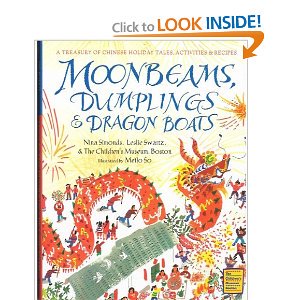
Moonbeams, Dumplings & Dragon Boats: A Treasury of Chinese Holiday Tales, Activities & Recipes by Nina Simonds ($14.28)
I love that this book has recipes! Nina Simonds is a very well respected cookbook author, she’s a specialist in Chinese cuisine. ~Jaden
Filled with delectable recipes, hands-on family activities, and traditional tales to read aloud, this extraordinary collection will inspire families everywhere to re-create the magic of Chinese holidays in their own homes. They can feast on golden New Year’s dumplings and tasty moon cakes, build a miniature boat for the Dragon Boat Festival and a kite at Qing Ming, or share the story of the greedy Kitchen God or the valiant warrior Hou Yi.
This stunning compilation from bestselling cookbook author Nina Simonds and Leslie Swartz of the Children’s Museum, Boston, is the perfect gift for families that have embraced Chinese holidays for generations–and for those just beginning new traditions.
Chinese Feasts & Festivals: A Cookbook by S.C. Moey ($18.21)
Beautiful hand-illustrated book with authentic Chinese recipes for many different Chinese festivals, such as The Dragon Boat Festival, Mooncake Festival and of course Chinese New Year. Gorgeous book and definitely worth every penny. ~Jaden
The rich culinary tradition of China is largely inspired by a calendar year filled with joyous occasions for eating, drinking and making merry. Food, fittingly enough, plays a leading role in everything from festivals to reunions and weddings to anniversaries. The combination of flavors and symbols, such as wealth, happiness, luck, and prosperity, involved in many of these dishes are a spiritual celebration and an earthly pleasure.
In Chinese Feasts & Festivals, author S.C. Moey assembles facts and fancies along with a collection of festival specialties that every Chinese food lover will read and enjoy. Full of delicate, subtly-rendered illustrations, this exquisite and yet functional cookbook will inspire you to cook up a feast no matter what the occasion.
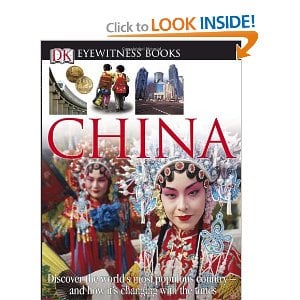 China: DK Eyewitness Books by Hugh Sebag-Montefiore ($10.87)
China: DK Eyewitness Books by Hugh Sebag-Montefiore ($10.87)
You’ll learn much more than about Chinese New Year in this beautifully photographed book. Highly recommended and great for all ages -Jaden
China investigates the present-day culture of the most populous country on the planet, and Oil takes a look at the controversial substance responsible for the beginning-and, if we’re not careful, the end of life as we know it today. Includes clip-art CD and wall poster.
Dragon Dance: A Chinese New Year Lift the Flap Book by Joan Holub ($6.99)
It’s Chinese New Year and there are so many fun things to do! Shopping at the outdoor market for fresh flowers, eating New Year’s dinner with the whole family, receiving red envelopes from Grandma and Grandpa, and best of all-watching the spectacular Chinese New Year’s parade! Introduce the customs of Chinese New Year to even the youngest readers with this festive new lift-the-flap book.
Illustrated by Benrei Huang.
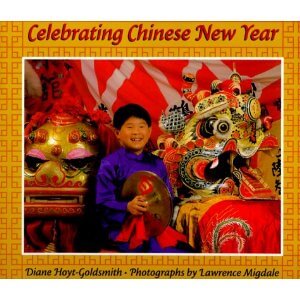
Celebrating Chinese New Year by Diane Hoyt-Goldsmith ($6.95)
Review from School Library Journal: Grade 1-5 Hoyt-Goldsmith and Migdale have done a stellar job of bringing readers into a holiday celebration. Beginning with the pre-New Year preparations, children follow 10-year-old Ryan Leong and his family as they celebrate the Chinese New Year in San Francisco. Through big, bright photographs and a clear, easy-to-follow text, readers see the preparations and festivities and learn about the history and traditions. The author includes the symbolic meanings of the foods eaten and other customs, an explanation of the Chinese Zodiac, and an in-depth look at the Lion Dance. The book is more detailed than Kate Waters’s Lion Dancer (Scholastic, 1990) and June Behrens’s Gung Hay Fat Choy (Children’s, 1982). The color photographs make it more inviting than Tricia Brown’s Chinese New Year (Holt, 1995). Hoyt-Goldsmith’s excellent book makes the Chinese New Year celebration accessible and understandable to all children. (c) Copyright 1996 Reed Business Information, Inc.
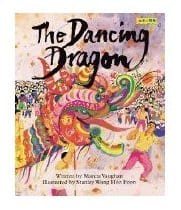 The Dancing Dragon by Marcia K. Vaughan
The Dancing Dragon by Marcia K. Vaughan
Review from School Library Journal: Kindergarten-Grade 2-In rhymed couplets, a Chinese-American child describes the excitement, preparation, and festivities of the Chinese New Year, culminating in a parade that includes a magnificent dragon carried aloft on sticks. The format of the book is foldout cardboard; for best effect, after reading it aloud, stand it on a table to show the eight-page panorama of this fine, fierce creature and the appreciative throng of celebrators in the streets of Chinatown. The watercolor-and-gouache illustrations are full of bright colors and action, reflecting the culture and the festivities. Combine this title with Kate Waters and Madeline Slovenz-Low’s Lion Dancer (Scholastic, 1990), which is more detailed and full of vibrant photographs. Carolyn Jenks, First Parish Unitarian Church, Portland, ME Copyright 1996 Reed Business Information, Inc.
 Sam and the Lucky Money by Karen Chinn
Sam and the Lucky Money by Karen Chinn
Amazon.com review: It’s Chinese New Year in Chinatown, and young Sam has four dollars of New Year money burning a hole in his pocket. As he and his mother are milling through the crowded streets–alive with firecrackers, lion dances, and shoppers–Sam accidentally steps on the foot of a homeless man who is buried in a pile of red paper. Flustered, Sam hurries back to his mother, and is soon distracted by the char siu bao and other sweets he might buy with his gift money. When he sees fish-tail cookies that remind him of toes, he remembers the old man again, and Sam starts to think of his “lucky money” in a new light. Karen Chinn’s winning story is perfectly complemented by the vibrant watercolors of Cornelius Van Wright and Ying-Hwa Hu, creators of the award-winning Zora Hurston and the Chinaberry Tree and A House by the River. Voted “Pick of the Lists” by American Bookseller, Sam and the Lucky Money succeeds at telling a simple story, while allowing young readers to explore the sights and sounds of an American urban Chinatown during the Chinese New Year. (Ages 4 to 8)
More Resources for Chinese New Year
Customs and Traditions of Chinese New Year – Chinatown Connection
Celebration of the Chinese New Year – Chinese Culture Center of San Francisco
Fun Chinese New Year crafts for kids – Enchanted Learning
A Guide to Chinese New Year – About.com
Free Chinese wallpapers, info on zodiac calendar – The Holiday Spot
Chinese New Year teacher resources – Teacher Planet
Chinese New Year e-Cards from Blue Mountain
Dragon Dance videos – YouTube
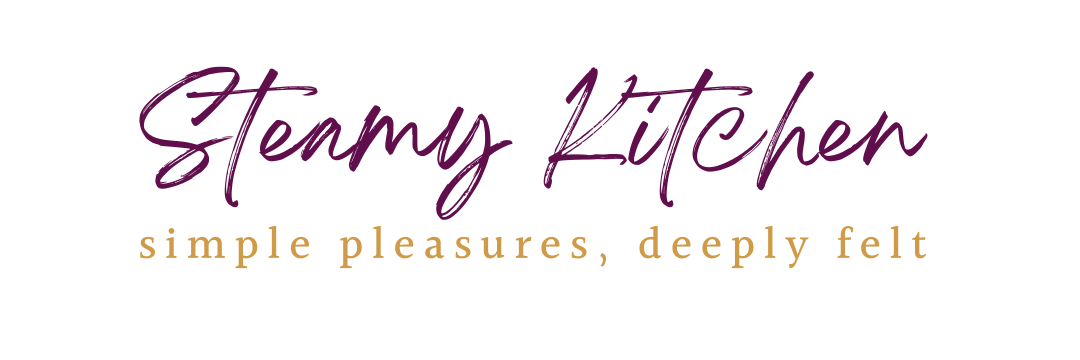
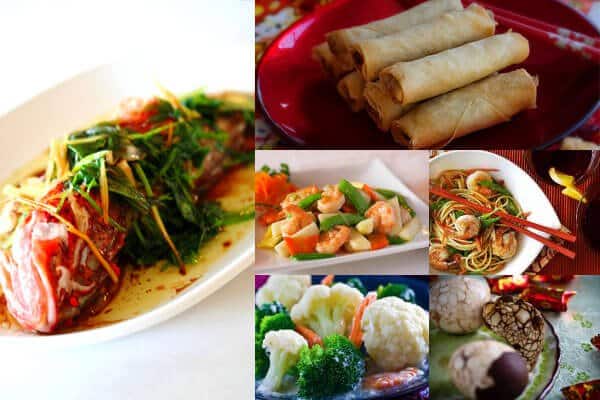
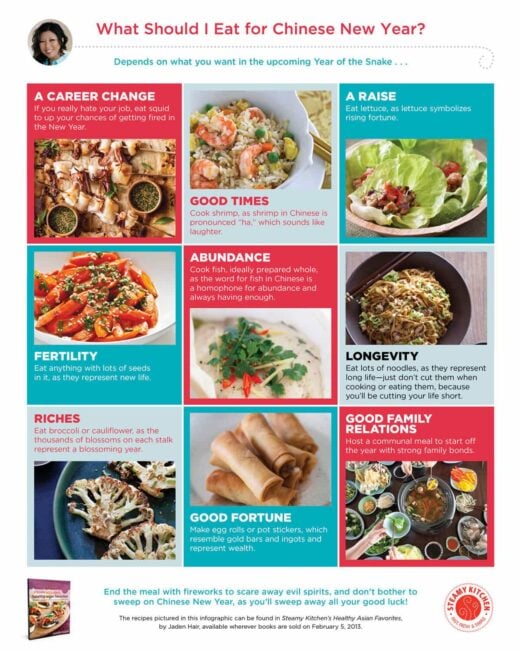



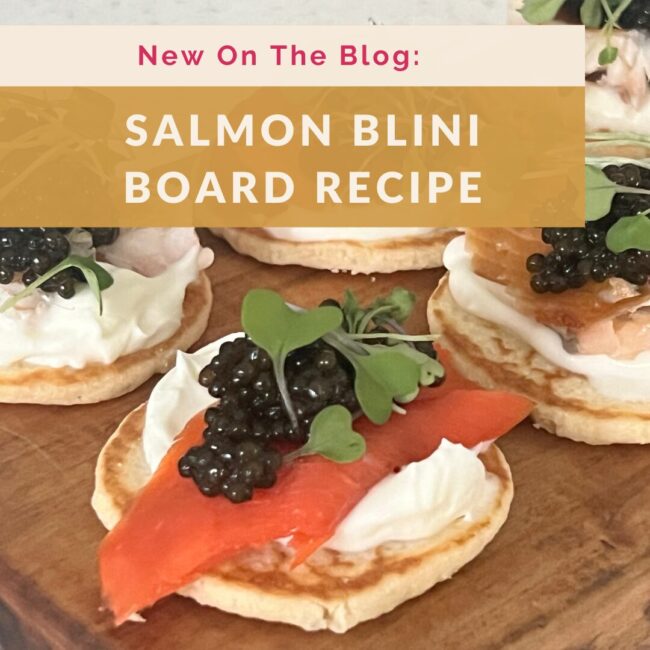


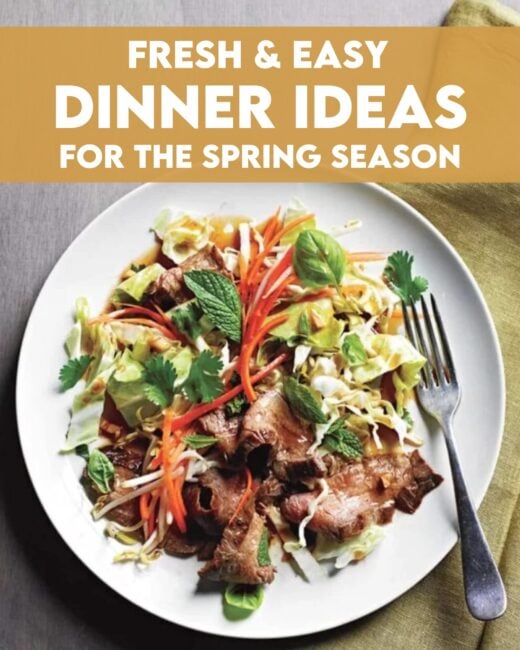
Hi, thanks for sharing so much info about the upcoming New Year. Your recipes look awesome. I have my set of personal fav recipes that I usually prepare for the occassion. Sharing them with you here.
http://www.ifood.tv/recipe/peking-duck-10
http://www.ifood.tv/recipe/kung-pao-chicken-cantonese-style
http://www.ifood.tv/recipe/roast-duck-with-hoisin-sauce-in-chinese-pancakes
http://www.ifood.tv/recipe/chinese-almond-cookies-7
I know it’s not Chinese New Year now, but do you have a recipe for puff-pastry-like flaky egg custard tarts? Thanks in advance!
Check rasamalayisa.com. You might also search for portuguese egg tarts – similar to “dan tat”
That picture looks great, all that good food! Happy New year!
Gong xi fa cai! Thanks for some great New Year feast ideas.
I loved reading this! I certainly not eating squid!
Happy NEW YEAR!!!! Gung Hay Fat Choy!
Thanks for the info, Jaden. My family doesn’t usually make eggrolls, but we always make chicken, and of course jai (vegetarian dish), and sweet fried dumplings. It’s always interesting to hear about each family and regional Chinese traditions. Wishing you and your family a happy new year!
Thanks for this elaborate post! THe collection of recipes is so useful for this holiday.
Happy Lunar New Year!
My favorite is the nian gao. Gotta ‘grow’ every year, even though my height has probably stopped growing already. 🙂
Thank you also for this post. I ordered the Dragon Dance book for my granddaughters. I wish I lived closer to Sarasota as I understand there are some special Chinese New Year events taking place there.
Great post and fantastics links! The CNY food superstitions are an interesting read especially for many overseas Chinese where the culture and traditions are somewhat lost. Happy Chinese New Year!
Great post and fantastics links! The CNY food superstitions are an interesting read especially for many overseas Chinese where the culture and traditions are somewhat lost.
My girls LOVE these–we always get them at our favorite restaraunt here in town. They will be so happy if we can make something relatively similar at home! Thanks. Valerie
Thanks, Jaden!
Thanks, Christine! I like the cookie one better, but they are both yummy! Can’t wait to try your recipe.
Thanks, Jaden. Can’t wait to try.
I bet no one is going to leave this post without knowing more about the Chinese New Year. Just learned that I should avoid the tofu : ), thanks!
Hi Dee & Jaden,
There are two kinds of crusts of Dan Tat (Egg tart).
Yes, as Jaden said, the pastry-like (酥皮底) crust is very difficult to make, and very time consuming.
Thanks Jaden for pointing. 🙂
But the one with cookie-like base is very simple and easy.
Here’s my recipe for making the cookie-like(牛油皮底)crust.
http://en.christinesrecipes.com/2009/03/cantonese-egg-tarts-recipe.html
Thanks for the linky links!
happy chinese new year to you and family
thank you for linking some of the auspicious recipes from my blog.
you have a lovely post here
Happy Chinese New Year and thank you for linking me.
this is really a lovely post.
I thoroughly promise that I shall NOT eat squid or tofu during Chinese New Year. And since I’m never really sure when that is, I’ll just swear off of tofu and squid for the rest of the year. Next year too.
^^I concur–great post! I also couldn’t get to the pineapple tart recipe–kept going to tangerine pie also…
Also, it might not be traditional for the new year, but really like Dan Tat–do you have Dan Tat recipe? ;p
Hi Dee! Thanks for pointing out – fixed.
For Dan Tat – It’s really hard to make the crust – but here’s a cheater version: http://en.christinesrecipes.com/2010/08/egg-custard-pastries-cheating-version.html
Hi Jaden
Happy New Year to you and family. Love this blog about CNY. You wrote it so well. Thanks for the reminders of dos and don’ts.. LOL 😉 I bought new clothes this year! yay!
Also, the link to pineapple tarts, went to tangerine pichet?
I lived in Hong Kong for a little while and this was my absolute favorite time of year! Thanks for sharing your recipes…and musings. Brought me right back! Gong Hay Fat Choy!
Thanks so much! Two of our three daughters were born in China and are now old enough to be interested in helping in the kitchen as the new year approaches. (Can’t get them to help with the cleaning, drat it all). I also love the listing of all the books (most of which we own). Thanks again. (PS We love the ribs recipe from your book. )
I love this post and enjoyed learning what you should/should not eat for the Chinese New Year. I REALLY want to make your mom’s egg rolls. Or maybe the dumplings…
What a fantastic post, Jaden! I did some research on Chinese New Year last year and was fascinate to learn about the significance of certain foods and days within the celebration. I am looking forward to trying some of your recipes this year.
What a wonderful hand-picked list you’ve compiled, Jaden. Got many fantastic dishes for Chinese New Year here in one place that my family would surely have every year. Thanks for your linking and effort plus time to gather the recipes, important things to know and references. Brilliant job!!!
Wish you have a Happy Year of the Rabbit!
Thank you for the wonderful blog!
Hi Jaden,
I try to log on to Hainanese Chicken Rice recipe but kept ending up with the fresh pear and shrimp recipe which I will also try it out. Will you fix the problem for I really like the chicken rice recipe very much I writing from San Francisco.
Thank you
Oh thanks for pointing that out. It’s fixed! Here’s the link
https://steamykitchen.com/5068-hainanese-chicken-rice.html
Thank you so much for posting this. The Chinese New Year has always fascinated me and I love learning about Chinese cuisine and tradition. Kung hee fat choy!
i’m attending a chinese new year party next week and have to bring a dish. i’ve been trying to figure out what to bring, and this blog post has been super helpful! thanks so much!
kung hee fat choy!